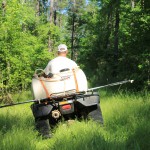
A boom sprayer such as this will cover a larger area and still allow good access through your areas.
If you live in either North Carolina, South Carolina, or Georgia you know the scourge of the sweetgum tree. Nothing (with a few exceptions) is prolific, invasive and intrusive as the sweetgum tree.
After pine thinning a few years ago, I realized firsthand the impact this tree has on our forest. Within a few months, small sweetgum’s began to sprout. Their seeds having lay dormant for sometimes decades waiting for the right amount of sunlight to hit the ground for them to grow. Within a few weeks these seedlings were saplings, and by the end of the summer, they were over four feet tall. Now three years later they are well established trees invading our pine stand.
Over the past few years we have tried several methods to rid this plague from our property to no avail. First I have tried and am still trying mowing the saplings. In the logging roads, cut lanes and any other area I can drive my mower, I am mowing anything three inches in diameter and smaller. After mowing, I wait for them to sprout, which is usually only a week or so, but I will let them get about six inches to a foot. Typically this is about a month after mowing. I follow this with a spraying of a strong herbicide designed for woody plants. Lesson learned here – if the sweetgum gets over a foot tall, the spray merely stunts the growth and causing twisting of the trunk but it survives. Anything less than a foot tall is killed for the season.
Last year after spending several hundred dollars on herbicide, I was thrilled to see the dying leaves of the sweetgum. Only to be disheartened that this spring those same stumps are sprouting again with new growth. An additional mowing is in the planning stages with a spray coming soon afterwards of a stronger herbicide.
What I learned is that sweetgum trees are colony trees. Meaning that one stump can and does throw off many trees from the same root system. Killing one of the trees does not kill the colony. The entire colony must be treated. The problem arises when there is literally no way to know how many trees are part of the colony. So every tree must be treated.
In the last post we discussed ‘hack and squirt’. This technique is excellent for trees too big to mow. The smaller trees can be mowed and then sprayed once they sprout in response to the mowing.
One thing to keep in mind is that due to the density of most forest, all of the sweetgum cannot be eliminated without severe measures. Some of these are costly, others are a better bang for your buck.
One such method is using heavy equipment to spray taller mature trees. Some applications use skidder machines loaded with very large tanks and high pressure nozzles. They cover an area of forty to fifty feet. These machines drive down roads, and cut lanes spraying in every direction. By using a herbicide that is designed for these type of trees, it is effective and fairly affordable. Usually costing between $75 and $125 per acre. I would consult with a registered forester before applying any herbicide to standing forest to ensure you are not killing your desired trees.
The last method is one that is debated among foresters and that is the use of prescribed fire. But there is more to it than just setting the woods on fire and hoping to kill the sweetgums. Again, a registered forester can assist with this planning and establishing the needed techniques.
Personally, my plan is to implement the hack and squirt, mowing and spraying and then in late summer, completing the task with what is known as a warm season burn. By burning the sweetgums before they go dormant, the success in killing them is much greater than conducting a cold weather burn when the sap and nutrients are at their lowest levels often below ground level. Some foresters believe that conducting a cold weather burn will only enhance the growth of the sweetgum by removing everything else that is competing for the nutrients.
There is little debate that this plant has little value, and costs hunters and landowners hundreds and thousands of dollars annually. Try some of these techniques and it should help you gain some control over your scourge of the Sweetgum tree.




